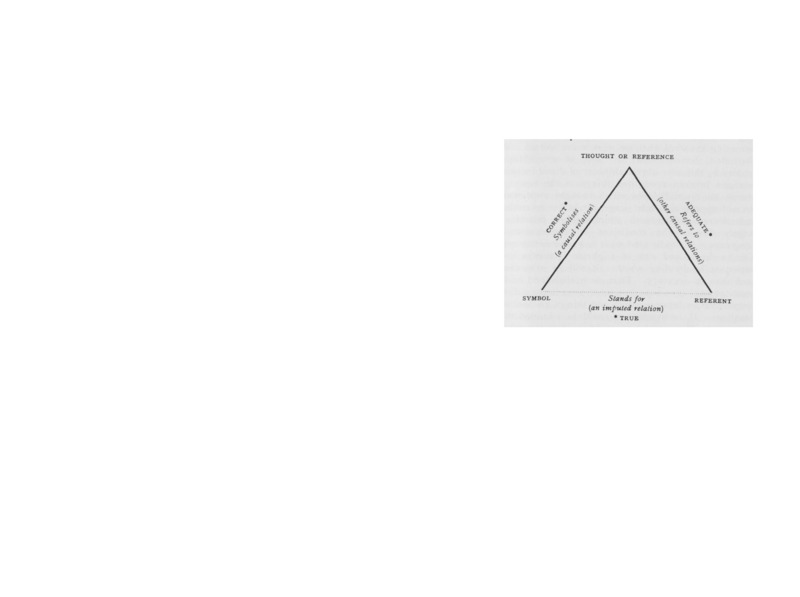ogden-richards-triangle.pdf
Media
Part of Triangle of Reference (Thoughts, Words and Things)
- extracted text
-
THE MEANING OF MEANING
I
that they did, as we shall see in the next chapter, was
once equally universal. It is only when a thinker
makes use of them that they stand for anything, or,
~n one sense, have 'meaning.' They are instruments.
But besides this referential use which for all reflective,
intellectual use of language should be paramount,
words have other functions which may be grouped
together as emotive. These can best be examined
when the framework of the problem of strict statement
and intellectual communication has been set up. The
importance of the emotive aspects of language is not
thereby minimized, and anyone chiefly concerned with
popular or primitive speech might well be led to reverse
this order of approach. Many difficulties, indeed,
arising through the behaviour of words in discussion,
even amongst scientists, force us at an early stage
to take into account these 'non-symbolic' influences.
But for the analysis of the senses of 'meaning' with
which we are here chiefly concerned, it is desirable to
begin with the relations of thoughts, words and things
as they are found in cases of reflective speech uncomplicated by emotional, diplomatic, or other disturbances ;
and with regard to these, the indirectness of the
relations between words and things is the feature
which first deserves attention.
· This may be simply illustrated by a diagram, in
which the three factors involved whenever any statement is made, or understood, are placed at the corners
of the triangle, the relations which hold between them
being represented by the sides. The point just :naqe
can be restated by saying that in this respect the base
of the triangle is quite different in composition from
either of the other sides.
Between a thought and a symbol causal relations
hold. When we speak, the symbolism we employ is
caused partly by the reference we are making and
partly by social and psychological factors-the purpose
for which we are making the reference, the proposed
THOUGHTS, WORDS AND THINGS
II
effect of our sym bois on other persons, and our own
attitude. When we hear what is said, the symbols
both cause us to perform an act of reference and to
assume an attitude which will, according to circumstances, · be more or less similar to the act and the
attitude of the speaker.
THOUGHT OR REFERENCE
SYMBOL
Stands for
(an imputed relation)
REFERENT
*TRUE
Between the Thought and the Referent there is also
a relation ; more or less direct (as when we think about
or attend to a coloured surface we see), or indirect (as
when we 'think of' or 'refer to' Napoleon), in which
case there may be a very long chain of sign-situations
intervening between the act and its referent: wordhistorian-contemporary record-eye-witness-referent
(Napoleon).
Between the symbol and the referent there is no
relevant relation other than the indirect one, which
- consists in its being used by someone to stand for a
referent. Symbol and Referent, that is to say, are not
con?ected directly (and when, for grammatical reasons,
we Imply such a relation, it will merely be an imputed, 1
• Cf. Chapter V., pp. ror-2 .
1 See Chapter VI., p. II6.
